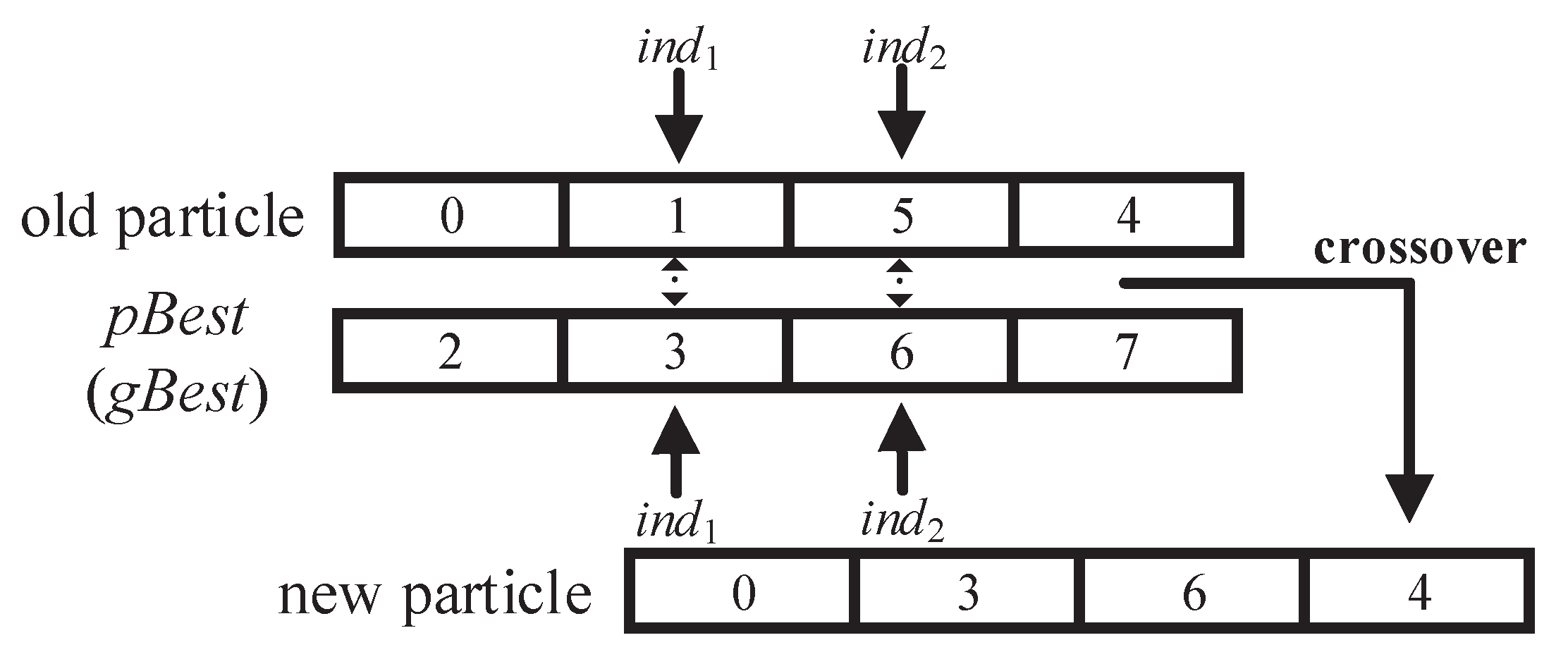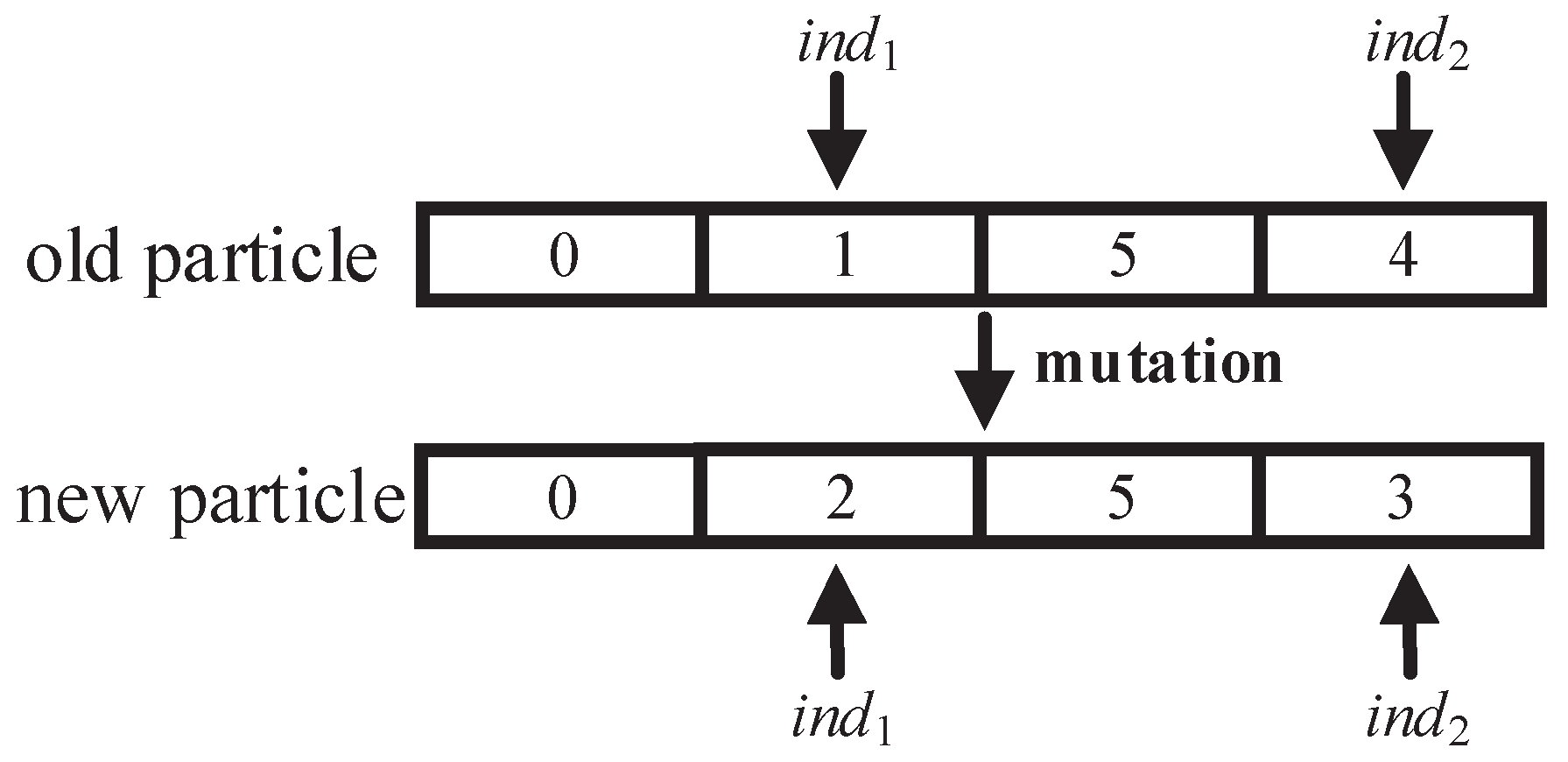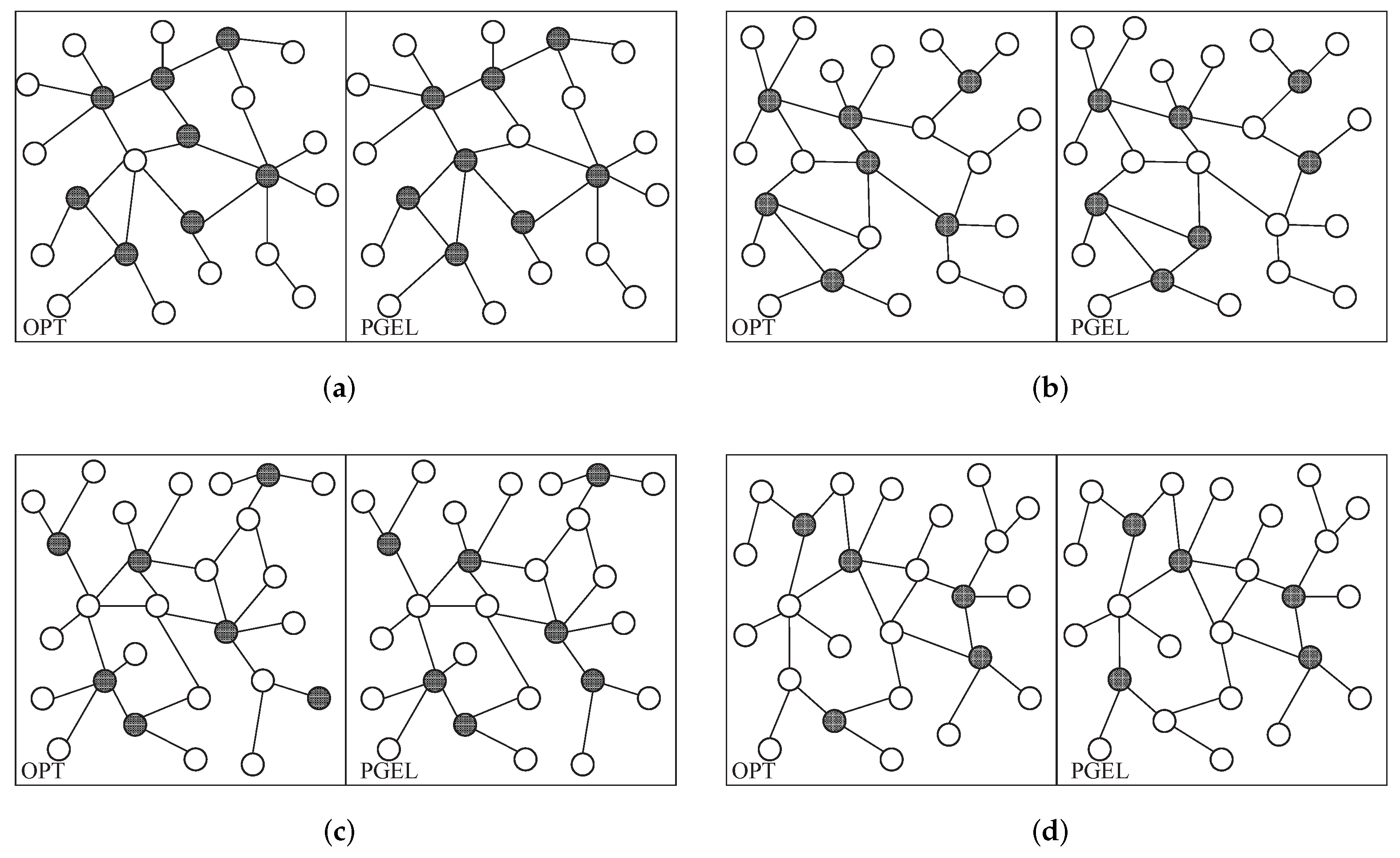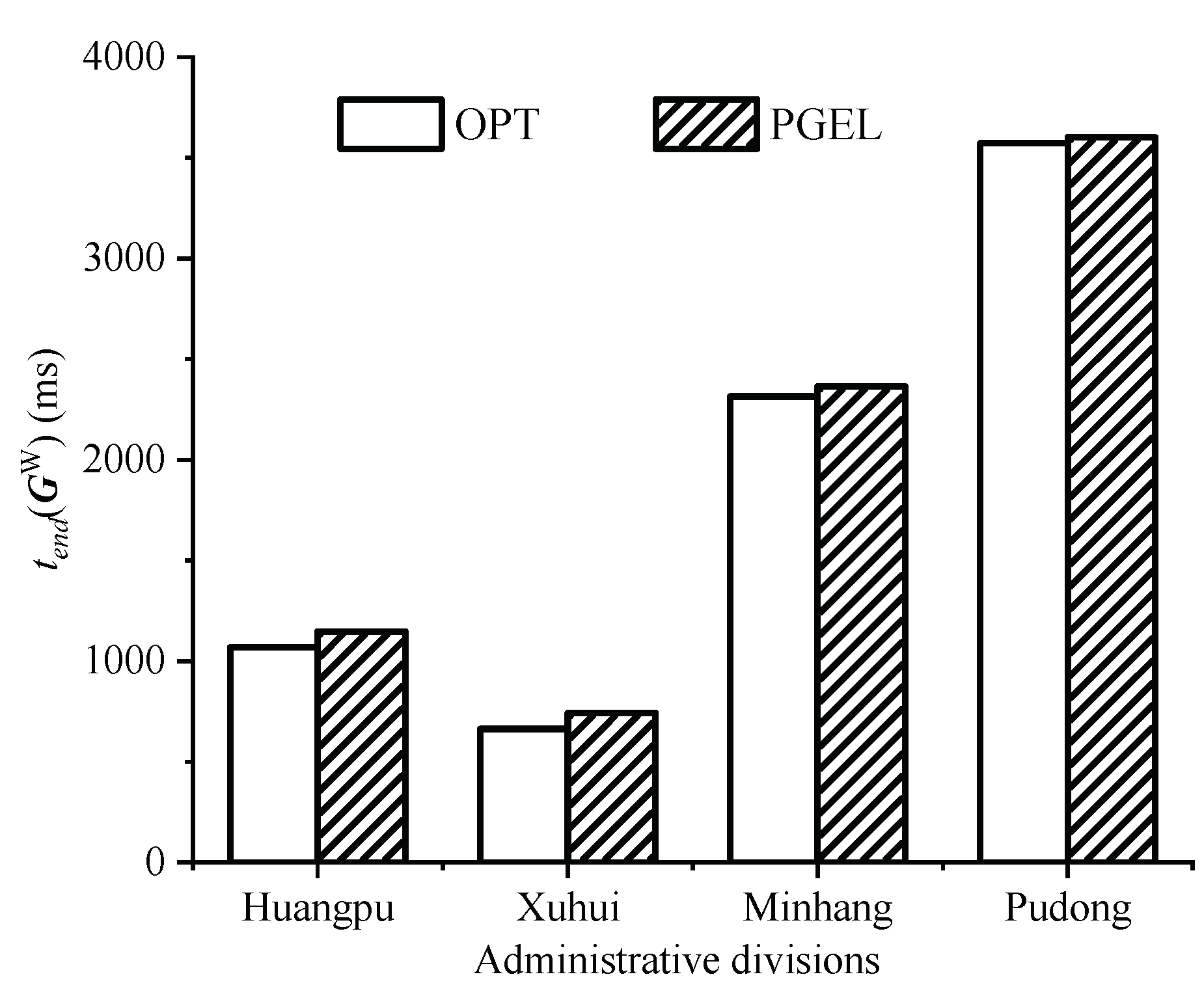A Time-Driven Cloudlet Placement Strategy for Workflow Applications in Wireless Metropolitan Area Networks
Abstract
:1. Introduction
- •
- We propose an abstract model of a cloudlet placement system in the WMAN. In this system model, mobile applications are WAs with complex internal dependencies. With the object of minimizing the execution time of WAs, a detailed mathematical analysis and modeling of the K cloudlet placement problem in a WMAN is performed.
- •
- The particle encoding and location update mode processes in the traditional particle swarm optimization (PSO) algorithm are improved, and the cloudlet placement strategy based on the PSO algorithm using genetic algorithm (GA) operators with the encoding library updating mode (PGEL) is proposed. By introducing the update operator of the GA and the encoding library update mode in the particle update process, this strategy solves the problems of easily falling into local optima and redundant operations during the particle update process that are encountered in the traditional PSO algorithm.
- •
- To verify the effectiveness and superiority of the proposed strategy, we conducted sufficient simulation experiments. The experimental results show that the proposed strategy not only obtains a near-optimal cloudlet placement scheme in typical WMANs, but also maintains excellent performance when the WMAN changes. This approach also has a major advantage when evaluated against several classic algorithms.
2. Related Work
3. System Model and Problem Formulation
3.1. System Model
3.1.1. WMAN Model
3.1.2. WA Model
3.1.3. Cloudlet Placement and Sub-Task Offloading
3.1.4. WA Execution Time
3.2. Problem Formulation
4. Cloudlet Placement Strategy Based on PGEL
4.1. Traditional PSO
4.2. PGEL
4.2.1. Problem Encoding
4.2.2. Fitness Function
4.2.3. Update Strategy
- A.
- Traditional updating mode.
- (1)
- Initialization: Randomly encode all encoding bits of the particle and ensure that the encodings are not equal.
- (2)
- Crossover: If the particle’s encoding obtained by the crossover operator conflicts with the original encoding, it does not meet the constraint that an AP places only a cloudlet, but needs to adjust the encoding according to certain rules (such as the most equivalent replacement method) to ensure that every two encodings are not equal. As shown in Figure 5, the crossed 2 and 4 conflict with the original encoding and need to be adjusted to avoid conflict.
- (3)
- Mutation: Similarly, if the particle’s encoding obtained by the mutation operator conflicts with the original encoding, the mutated encoding needs to be adjusted to ensure that the two encodings are not equal. As shown in Figure 6, 5 in the original encoding changes to 1, and the new encoding conflicts with the original encoding. One of the adjustment schemes is to change 1 to 5 in the mutated encoding.
- B.
- Encoding library updating mode.
- (1)
- Initialization: When the particles are initialized, the encodings are removed from the encoding library one by one so that they do not conflict.
- (2)
- Crossover: In the process of executing the crossover operator, first add the replaced encodings of the particle back to their own encoding library, and then, check the encodings obtained by the cross one by one. If encoding exists in the encoding library, delete it from the encoding library. If encoding does not exist in the encoding library, the closest encoding is selected from the encoding library to replace it. The label of the AP is determined by its specific spatial location, so the location of the access point in the network represented by the closest value is the closest, so the above operation can retain the original particle placement scheme to the greatest extent.
- (3)
- Mutation: When the mutation operator needs to be executed, an encoding is randomly selected from the encoding library to replace the original encoding, and then, the original encoding is added to the encoding library.
4.2.4. Map from a Particle-to-Cloudlet Placement Scheme
| Algorithm 1: Mapping particle to cloudlet placement scheme |
| Input: Paticle . |
| Output: Cloudlet placement scheme . |
| 1 begin |
| 2 foreach do |
| 3 ; |
| 4 end |
| 5 foreach do |
| 6 ; |
| 7 end |
| 8 return |
| 9 end |
4.2.5. Parameter Settings
4.2.6. Algorithm Flow
4.3. Time Complexity
5. Performance Evaluation
- •
- RQ1: Can PGEL obtain a near-optimal cloudlet placement scheme in typical WMANs? (Section 5.3)
- •
- RQ2: What is the impact of changes in the WMAN on the performance of PGEL? (Section 5.4)
- •
- RQ3: In typical WMANs, compared with several classic algorithms, does PGEL have performance advantages when solving KCPWP? (Section 5.5)
5.1. Experimental Settings
5.2. Classic Algorithms
- •
- Optimal placement algorithm (OPT): This algorithm traverses all possible cloudlet placement schemes and selects the placement scheme with the minimum execution time of WAs as the optimal cloudlet placement scheme.
- •
- PSO: This traditional PSO algorithm has the same encoding and parameter settings as PGEL.
- •
- GA: According to the update strategy of the GA, it uses the elite retention strategy, binary tournament selection operator, two-point crossover operator, and exchange mutation operator to update the chromosome and takes the final elite solution as the optimal solution. The crossover and mutation probability were set as 0.7 and 0.1, respectively.
- •
- Random cloudlet placement algorithm (RAN): This algorithm randomly selects K from all APs of the WMAN and randomly places K to-be-placed cloudlets on these APs. The result is an average of 100 repetitions.
5.3. RQ1. PGEL Can Obtain a Near-Optimal Cloudlet Placement Scheme in Typical WMANs
5.4. RQ2. The Changes in the WMAN Have Almost No Impact on the Performance of PGEL
5.4.1. The Impact of Changes in AP Topology on the Performance of PGEL
5.4.2. The Impact of the Changes in the To-Be-Placed Cloudlet CPU Clock Frequency on the Performance of PGEL
5.4.3. The Impact of the Changes in WAs on the Performance of PGEL
5.5. RQ3. PGEL Has Greater Performance Advantages than Several Classic Algorithms in Typical WMANs Do
6. Conclusions
Author Contributions
Funding
Institutional Review Board Statement
Informed Consent Statement
Data Availability Statement
Conflicts of Interest
References
- Liu, F.; Shu, P.; Jin, H.; Ding, L.; Yu, J.; Niu, D.; Li, B. Gearing resource-poor mobile devices with powerful clouds: Architectures, challenges, and applications. IEEE Wirel. Commun. 2013, 20, 14–22. [Google Scholar]
- Huang, D.; Xing, T.; Wu, H. Mobile cloud computing service models: A user-centric approach. IEEE Netw. 2013, 27, 6–11. [Google Scholar] [CrossRef]
- Jararweh, Y.; Doulat, A.; AlQudah, O.; Ahmed, E.; Al-Ayyoub, M.; Benkhelifa, E. The future of mobile cloud computing: Integrating cloudlets and mobile edge computing. In Proceedings of the International Conference on Telecommunications (ICT), Thessaloniki, Greece, 16–18 May 2016. [Google Scholar]
- Xu, Z.; Liang, W.; Xu, W.; Jia, M.; Guo, S. Efficient algorithms for capacitated cloudlet placements. IEEE Trans. Parallel Distrib. Syst. 2015, 27, 2866–2880. [Google Scholar] [CrossRef]
- Xu, Z.; Liang, W.; Xu, W.; Jia, M.; Guo, S. Capacitated cloudlet placements in wireless metropolitan area networks. In Proceedings of the IEEE 40th Conference on Local Computer Networks (LCN), Clearwater Beach, FL, USA, 26–29 October 2015. [Google Scholar]
- Jia, M.; Cao, J.; Liang, W. Optimal cloudlet placement and user to cloudlet allocation in wireless metropolitan area networks. IEEE Trans. Cloud Comput. 2015, 5, 725–737. [Google Scholar] [CrossRef]
- Chen, M.; Guo, S.; Liu, K.; Liao, X.; Xiao, B. Robust computation offloading and resource scheduling in cloudlet-based mobile cloud computing. IEEE Trans. Mob. Comput. 2021, 20, 2025–2040. [Google Scholar] [CrossRef]
- Chun, B.G.; Ihm, S.; Maniatis, P.; Naik, M.; Patti, A. Clonecloud: Elastic execution between mobile device and cloud. In Proceedings of the Sixth Conference on Computer Systems (CCS), Salzburg, Austria, 10–13 April 2011. [Google Scholar]
- Cuervo, E.; Balasubramanian, A.; Cho, D.k.; Wolman, A.; Saroiu, S.; Chandra, R.; Bahl, P. MAUI: Making smartphones last longer with code offload. In Proceedings of the 8th International Conference on Mobile Systems, Applications, and Services (ICMAS), San Francisco, CA, USA, 15–18 June 2010. [Google Scholar]
- Kosta, S.; Aucinas, A.; Hui, P.; Mortier, R.; Zhang, X. Thinkair: Dynamic resource allocation and parallel execution in the cloud for mobile code offloading. In Proceedings of the IEEE International Conference on Computer Communications (INFOCOM), Orlando, FL, USA, 25–30 March 2012. [Google Scholar]
- LAN/MAN Standards Committee. IEEE Standard for Local and Metropolitan Area Networks: Overview and Architecture (En línea); The Institute of Electrical and Electronics Engineers Inc.: New York, NY, USA, 2002. [Google Scholar]
- Luo, Q.; Li, C.; Luan, T.H.; Shi, W.; Wu, W. Self-learning based computation offloading for internet of vehicles: Model and algorithm. IEEE Trans. Wirel. Commun. 2021, 20, 5913–5925. [Google Scholar] [CrossRef]
- Tan, J.; Chang, T.H.; Guo, K.; Quek, T.Q. Robust computation offloading in fog radio access network with fronthaul compression. IEEE Trans. Wirel. Commun. 2021, 20, 6506–6521. [Google Scholar] [CrossRef]
- Ha, K.; Pillai, P.; Richter, W.; Abe, Y.; Satyanarayanan, M. Just-in-time provisioning for cyber foraging. In Proceedings of the 11th Annual International Conference on Mobile Systems, Applications, and Services (ICMAS), Taipei, Taiwan, 25–28 June 2013. [Google Scholar]
- Zhang, Y.; Liu, H.; Jiao, L.; Fu, X. To offload or not to offload: An efficient code partition algorithm for mobile cloud computing. In Proceedings of the IEEE 1st International Conference on Cloud Networking (CLOUDNET), Paris, France, 28–30 November 2012. [Google Scholar]
- Zhang, Y.; Huang, G.; Liu, X.; Zhang, W.; Mei, H.; Yang, S. Refactoring android Java code for on-demand computation offloading. In Proceedings of the Annual ACM SIGPLAN Conference on Object-Oriented Programming, Systems, Languages, and Applications (OOPSLA), Tucson, AZ, USA, 21–25 October 2012. [Google Scholar]
- Ra, M.R.; Sheth, A.; Mummert, L.; Pillai, P.; Wetherall, D.; Govindan, R. Odessa: Enabling interactive perception applications on mobile devices. In Proceedings of the The 9th International Conference on Mobile Systems, Applications, and Services (ICMAS), Bethesda MD, USA, 28 June–1 July 2011. [Google Scholar]
- Hoang, D.T.; Niyato, D.; Wang, P. Optimal admission control policy for mobile cloud computing hotspot with cloudlet. In Proceedings of the IEEE Wireless Communications and Networking Conference (WCNC), Paris, France, 1–4 April 2012. [Google Scholar]
- Guan, S.; Boukerche, A. A novel mobility-aware offloading management scheme in sustainable multi-access edge computing. IEEE Trans. Sustain. Comput. 2022, 7, 1–13. [Google Scholar] [CrossRef]
- Chen, X.; Hu, J.; Chen, Z.; Lin, B.; Xiong, N.; Min, G. A reinforcement learning-empowered feedback control system for industrial internet of things. IEEE Trans. Ind. Inform. 2022, 18, 2724–2733. [Google Scholar] [CrossRef]
- Zhang, Y.; Niyato, D.; Wang, P. Offloading in mobile cloudlet systems with intermittent connectivity. IEEE Trans. Mob. Comput. 2015, 14, 2516–2529. [Google Scholar] [CrossRef]
- Gai, K.; Qiu, M.; Zhao, H.; Tao, L.; Zong, Z. Dynamic energy-aware cloudlet-based mobile cloud computing model for green computing. J. Netw. Comput. Appl. 2016, 59, 46–54. [Google Scholar] [CrossRef]
- Mukherjee, A.; De, D.; Roy, D.G. A power and latency aware cloudlet selection strategy for multi-cloudlet environment. IEEE Trans. Cloud Comput. 2016, 7, 141–154. [Google Scholar] [CrossRef]
- Bhatta, D.; Mashayekhy, L. A bifactor approximation algorithm for cloudlet placement in edge computing. IEEE Trans. Parallel Distrib. Syst. 2021, 33, 1787–1798. [Google Scholar] [CrossRef]
- Jin, X.; Gao, F.; Wang, Z.; Chen, Y. Optimal deployment of mobile cloudlets for mobile applications in edge computing. J. Supercomput. 2022, 78, 7888–7907. [Google Scholar] [CrossRef]
- Chen, X.; Li, A.; Zeng, X.E.; Guo, W.; Huang, G. Runtime model based approach to IoT application development. Front. Comput. Sci. 2015, 9, 540–553. [Google Scholar] [CrossRef]
- Guo, Y.; Wang, S.; Zhou, A.; Xu, J.; Yuan, J.; Hsu, C.H. User allocation-aware edge cloud placement in mobile edge computing. Softw. Pract. Exp. 2020, 50, 489–502. [Google Scholar] [CrossRef]
- Wang, Z.; Gao, F.; Jin, X. Optimal deployment of cloudlets based on cost and latency in Internet of Things networks. Wirel. Netw. 2020, 26, 6077–6093. [Google Scholar] [CrossRef]
- Zhu, X.; Zhou, M. Multiobjective optimized cloudlet deployment and task offloading for mobile-edge computing. IEEE Internet Things J. 2021, 8, 15582–15595. [Google Scholar] [CrossRef]
- Cao, B.; Fan, S.; Zhao, J.; Tian, S.; Zheng, Z.; Yan, Y.; Yang, P. Large-scale many-objective deployment optimization of edge servers. IEEE Trans. Intell. Transp. Syst. 2021, 22, 3841–3849. [Google Scholar] [CrossRef]
- Dashti, S.E.; Rahmani, A.M. Dynamic VMs placement for energy efficiency by PSO in cloud computing. J. Exp. Theor. Artif. Intell. 2016, 28, 97–112. [Google Scholar] [CrossRef]
- Chou, L.D.; Chen, H.F.; Tseng, F.H.; Chao, H.C.; Chang, Y.J. DPRA: Dynamic Power-Saving Resource Allocation for Cloud Data Center Using Particle Swarm Optimization. IEEE Syst. J. 2018, 12, 1554–1565. [Google Scholar] [CrossRef]
- Tseng, F.H.; Wang, X.; Chou, L.D.; Chao, H.C.; Leung, V.C.M. Dynamic Resource Prediction and Allocation for Cloud Data Center Using the Multiobjective Genetic Algorithm. IEEE Syst. J. 2018, 12, 1688–1699. [Google Scholar] [CrossRef]
- Tseng, F.H.; Jheng, Y.M.; Chou, L.D.; Chao, H.C.; Leung, V.C. Link-Aware Virtual Machine Placement for Cloud Services based on Service-Oriented Architecture. IEEE Trans. Cloud Comput. 2020, 8, 989–1002. [Google Scholar] [CrossRef]
- Chen, Z.; Hu, J.; Chen, X.; Hu, J.; Zheng, X.; Min, G. Computation offloading and task scheduling for DNN-based applications in cloud-edge computing. IEEE Access 2020, 8, 115537–115547. [Google Scholar] [CrossRef]
- Kennedy, J.; Eberhart, R. Particle swarm optimization. In Proceedings of the International Conference on Neural Networks (ICNN), Perth, WA, Australia, 27 November–1 December 1995. [Google Scholar]
- Guo, W.; Lin, B.; Chen, G.; Chen, Y.; Liang, F. Cost-driven scheduling for deadline-based workflow across multiple clouds. IEEE Trans. Netw. Serv. Manag. 2018, 15, 1571–1585. [Google Scholar] [CrossRef]
- Shi, Y.; Eberhart, R. A modified particle swarm optimizer. In Proceedings of the IEEE International Conference on Evolutionary Computation Proceedings (ICECP), Anchorage, AK, USA, 4–9 May 1998. [Google Scholar]
- Wang, S.; Zhao, Y.; Huang, L.; Xu, J.; Hsu, C.H. QoS prediction for service recommendations in mobile edge computing. J. Parallel Distrib. Comput. 2019, 127, 134–144. [Google Scholar] [CrossRef]
- Chavan, T.R.; Nandedkar, A.V. A hybrid deep neural network for online learning. In Proceedings of the International Conference on Advances in Pattern Recognition (ICAPR), Bangalore, India, 27–30 December 2017. [Google Scholar]
- Zhang, J. GitHub. Available online: https://github.com/JamesZJS/dataset (accessed on 1 January 2022).










| Reference | Infrastructure | Server | Task Type | Constraint | Object | ||||||||
|---|---|---|---|---|---|---|---|---|---|---|---|---|---|
| Cloud | Edge | Terminal | Single | Multiple | Jobs | Workflow | Energy | Deadline | Time | Energy | Workload | Other | |
| Our work | + | + | + | − | + | − | + | − | + | + | − | − | − |
| [24] | − | + | + | − | + | + | − | − | − | + | − | − | − |
| [25] | − | + | + | − | + | + | − | − | − | − | − | − | + |
| [27] | + | + | + | − | + | + | − | − | − | + | − | + | − |
| [28] | − | + | + | − | + | + | − | − | + | + | − | − | + |
| [29] | − | + | + | − | + | + | − | − | − | + | + | − | − |
| [30] | − | + | + | + | − | + | − | − | − | − | − | − | + |
| [31] | + | − | + | − | + | + | − | − | − | + | + | − | − |
| [34] | + | − | + | − | + | + | − | + | − | + | + | − | + |
| Notation | Description |
|---|---|
| a WMAN | |
| AP with index i in the WMAN | |
| unit data transmission delay between and | |
| set of WAs received by all APs | |
| WA with index i | |
| sub-tasks included in WA | |
| data dependence between sub-tasks included in WA | |
| computational requirement of sub-task | |
| set of cloudlets to be placed in a WMAN | |
| computing power of cloudlet | |
| cloudlet placement scheme | |
| global sub-task offloading strategy | |
| start time of sub-task on cloudlet | |
| execution time of sub-task | |
| dependent data transmission time between sub-tasks and | |
| execution end time of sub-task on cloudlet | |
| execution end time of WA | |
| end time of all WAs in the WMAN |
Publisher’s Note: MDPI stays neutral with regard to jurisdictional claims in published maps and institutional affiliations. |
© 2022 by the authors. Licensee MDPI, Basel, Switzerland. This article is an open access article distributed under the terms and conditions of the Creative Commons Attribution (CC BY) license (https://creativecommons.org/licenses/by/4.0/).
Share and Cite
Zhang, J.; Li, M.; Zheng, X.; Hsu, C.-H. A Time-Driven Cloudlet Placement Strategy for Workflow Applications in Wireless Metropolitan Area Networks. Sensors 2022, 22, 3422. https://doi.org/10.3390/s22093422
Zhang J, Li M, Zheng X, Hsu C-H. A Time-Driven Cloudlet Placement Strategy for Workflow Applications in Wireless Metropolitan Area Networks. Sensors. 2022; 22(9):3422. https://doi.org/10.3390/s22093422
Chicago/Turabian StyleZhang, Jianshan, Ming Li, Xianghan Zheng, and Ching-Hsien Hsu. 2022. "A Time-Driven Cloudlet Placement Strategy for Workflow Applications in Wireless Metropolitan Area Networks" Sensors 22, no. 9: 3422. https://doi.org/10.3390/s22093422
APA StyleZhang, J., Li, M., Zheng, X., & Hsu, C.-H. (2022). A Time-Driven Cloudlet Placement Strategy for Workflow Applications in Wireless Metropolitan Area Networks. Sensors, 22(9), 3422. https://doi.org/10.3390/s22093422






